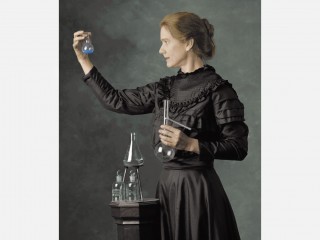
Curie, Marie Skłodowska biography
Date of birth : 1867-11-07
Date of death : 1934-07-04
Birthplace : Warsaw, Vistula Land, Russian Empire
Nationality : Polish
Category : Science and Technology
Last modified : 2010-04-01
Credited as : Famous polish physicist and chemist, Nobel prizes in physics and chemistry, radium and polonium
2 votes so far
She was born Maria Skłodowska in Warsaw (then in Vistula Land, Russian Empire; now in Poland) and lived there until she was twenty-four. In 1891 she followed her older sister Bronisława to study in Paris, where she obtained her higher degrees and conducted her subsequent scientific work. She founded the Curie Institutes in Paris and Warsaw. Her husband Pierre Curie shared her Nobel prize in physics. Her daughter Irène Joliot-Curie and son-in-law, Frédéric Joliot-Curie, also shared a Nobel prize.
Her achievements include the creation of a theory of radioactivity (a term she coined ), techniques for isolating radioactive isotopes, and the discovery of two new elements, polonium and radium. Under her direction, the world's first studies were conducted into the treatment of neoplasms (cancers) using radioactive isotopes.
While an actively loyal French citizen, she never lost her sense of Polish identity. She named the first new chemical element that she discovered polonium (1898) for her native country, and in 1932 she founded a Radium Institute (now the Maria Skłodowska–Curie Institute of Oncology) in her home town, Warsaw, headed by her physician sister Bronisława.
The discovery of Radium and Polonium
The scientific history of radium and polonium is awe-inspiring. In the year 1897, Madame Curie and her husband Professor Curie were working in the laboratory of Physics and Chemistry. While, Professor Curie held his lectures, Marie was engaged in some work on Uranium rays, which had been discovered two years ago by Professor BecquerMadame Curieel. She started working on the way of making good measurements of the uranium rays. She was also trying to know if there are any other elements, giving out the same kind of rays. She worked on all known elements, and their compounds. During her study, she found that uranium compounds were active and also all thorium compounds, but neither were the other elements active nor were their compounds. As for the uranium and thorium compounds, she found that they were active in proportion to their uranium or thorium content. Then she took up the measurements of minerals and found that several of them contained uranium or thorium, or both were active. Finally, she came to a conclusion that there should be some unknown element in the minerals having a much greater radioactivity than uranium or thorium. She was anxious to find out and isolate that element. She settled to work with her husband. It was not an easy task. They thought it would be done in several weeks or months, but it actually took them many years of hard work. As a result, the most important element, radium, could be separated in a pure state.
The properties of Radium
The properties of the rays of radium have been studied extensively. The particles, expelled from radium have a velocity equivalent to that of light. The atoms of radium are destroyed by expulsion of these particles, some of that are atoms of helium. Radium is not the only dement having these properties. Many other radioactive elements are already known like polonium, mesothorium, radiothorium, and actinium. There are also certain radioactive gases, named emanations.
The intensity of the rays of Radium is several million times greater than the uranium rays. This effect is what makes radium so important. From the practical point of view, the most important property of the rays is the production of physiological effects on the cells of the human organism. These effects may be used for the cure of several diseases. Effective results have been obtained in many cases, in the treatment of cancer. It’s medical utilization made it necessary to get that element in sufficient quantities. To fulfill the demand, the first factory of radium was started in France, and later in America where a big quantity of ore named carnotite is available. Although the production of radium is in many grams per year, the price is still high because the quantity of radium contained in the ore is very small. Radium is a hundred thousand times more expensive than gold.
When radium was discovered, no one knew that it would be prove to be useful in hospitals. The work that the Curie couple did was one of ‘Pure Sciences’. This is the proof that scientific work must never be considered from the point of view of its direct usefulness.
Pioneers of radioactive age
New discoveries at the end of the nineteenth century became of importance also for the blossoming of modern art. X-Ray photography focused art on the invisible. For the physicists of Madame Curie’s age, the new discoveries were no less revolutionary. During a radioactive decay, heat is given off from an invisible and apparently inexhaustible source and the radioactive element is subsequently transformed into new elements. Just as in the ancient dreams of an alchemist, the possibility of making gold, all these things contravened the most entrenched principles of classical physics. For radioactivity to be understood, the development of quantum mechanics was required. But it should be noted that the birth of quantum mechanics was not initiated by the study of radioactivity, but by Max Planck’s study of radiation from a black body in 1900. It was an old field that was not the object of the same interest and publicity as this new spectacular discovery. It was not until 1928, that the type of radioactivity that is called alpha decay obtained its theoretical explanation.
Much has changed in the conditions under which researchers worked, since Marie and Pierre Curie worked in a draughty shed. Their refusal to patent the discovery was more so in terms of their moral ethics as researchers. These might definitely have been looked down upon in those times.
















